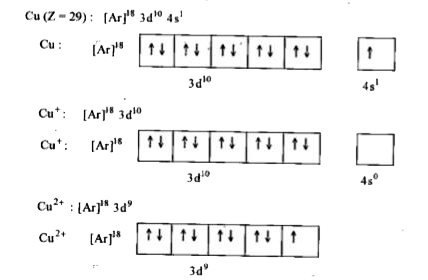Explain why Cu(I) is diamagnetic while Cu(II) is paramagnetic in nature? Solution in Punjabi
Electronic configuration of Cu (Z = 29), Cu+,Cu2+ as follows:
Cu(Z=29) : [Ar]18 3d10 4s1

Cu (I) is diamagnetic because it has 3d10 configuration and therefore is not unpaired electron on the other hand Cu(II) has 3d9 configuration and there is unpaired electron. So Cu (II) is Paramagnetic in nature.
Topper's Solved these Questions
- BOOK - ACCURATE PUBLICATIONCHAPTER - SOLVED MODEL TEST PAPER-3EXERCISE - SECTION C11videos
SOLVED MODEL TEST PAPER-3
- BOOK - ACCURATE PUBLICATIONCHAPTER - SOLVED MODEL TEST PAPER-2EXERCISE - SECTION D11videos
SOLVED MODEL TEST PAPER-2
- BOOK - ACCURATE PUBLICATIONCHAPTER - SURFACE CHEMISTRY EXERCISE - COMPREHENSION QUESTIONS49videos
SURFACE CHEMISTRY
Similar Questions
Discuss the reaction and mechanism of acidic dehydration of ethyl alcohol to prepare ether.
02:22View SolutionExplain Swarts reaction.
02:35View SolutionRead the given passage and answers following questions :
There are mainly two type of adsorption of gases on solids. If accumulation of gases on the surface of solid occurs on account of weak vander waal forces, the adsorption is termed as physical adsorption. When gas molecules or atoms held to solid surface by chemical bonds, adsorption is termed as chemical adsorption. The chemical bonds may be covalent or ionic. Chemical adsorption involves a high energy of activation therefore it is referred as Activated adsorption. A physical adsorption at low temperature may pass into chemical adsorption temperature is increased.
What type of force exist in physical adsorption ?02:35View SolutionCopper (I) is diamagnetic while copper (II) is paramagnetic . Explain.
03:13View SolutionCu2+ प्रतिचुम्बकीय है जबकि Cu2+ अनुचुम्बकीय है, क्यों ?
View SolutionCu2+ अनुचुम्बकीय है जबकि Zn2+ प्रतिचुम्बकीय है क्यों
05:09View SolutionCu+ प्रतिचुम्बकीय है जबकि Cu2+ अनुचुम्बकीय है। स्पष्ट करो।
02:23View SolutionCu(I) योगिक सफ़ेद एवं प्रतिचुंबकिय होता हैं जबकि Cu(II) योगिक रंगीन एवं अनुचुंबकिय होते हैं, क्यों?
04:56View SolutionCopper(I) is diamagnetic but copper(II) is paramagnetic-why?
05:24View SolutionGive reason:
Cu2+ is paramagnetic and Cu+ is diamagnetic.04:27View SolutionZn2+ प्रतिचुम्बकीय होता है जबकि Cu2+ अनुचुम्बकीय, क्यों?
01:19View Solution(i) How will you prepare ozone by laboratory method? Explain the structure of ozone. (ii) Cu^(+), Zn^(2+) are diamagnetic. Prove it.
05:20View Solution(a) What is lanthanoid contraction? What is the cause of lanthanoid contraction? (b) Explain whether Cu2+ is paramagnetic or diamagnetic.
01:37View SolutionWhy is 'NO' paramagnetic in nature ? When does it become diamagnetic ?
04:53View SolutionExplain why:
(i) Transition elements form coloured compounds. (ii) Cu+ is diamagnetic but Cu2+ is paramagnetic (Z=29)02:12View SolutionExplain why:
Cu+ is diamagnetic but Cu2+ is paramag netic. (Z=29)02:20View Solution

